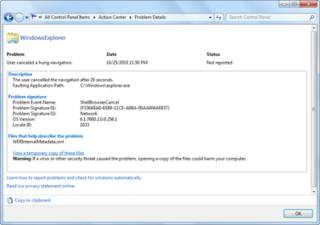
In computing, a database is an organized collection of data stored and accessed electronically through the use of a database management system. Small databases can be stored on a file system, while large databases are hosted on computer clusters or cloud storage. The design of databases spans formal techniques and practical considerations, including data modeling, efficient data representation and storage, query languages, security and privacy of sensitive data, and distributed computing issues, including supporting concurrent access and fault tolerance.
In computer science, ACID is a set of properties of database transactions intended to guarantee data validity despite errors, power failures, and other mishaps. In the context of databases, a sequence of database operations that satisfies the ACID properties is called a transaction. For example, a transfer of funds from one bank account to another, even involving multiple changes such as debiting one account and crediting another, is a single transaction.
In information technology and computer science, especially in the fields of computer programming, operating systems, multiprocessors, and databases, concurrency control ensures that correct results for concurrent operations are generated, while getting those results as quickly as possible.
A database transaction symbolizes a unit of work, performed within a database management system against a database, that is treated in a coherent and reliable way independent of other transactions. A transaction generally represents any change in a database. Transactions in a database environment have two main purposes:
- To provide reliable units of work that allow correct recovery from failures and keep a database consistent even in cases of system failure. For example: when execution prematurely and unexpectedly stops in which case many operations upon a database remain uncompleted, with unclear status.
- To provide isolation between programs accessing a database concurrently. If this isolation is not provided, the programs' outcomes are possibly erroneous.
In database systems, durability is the ACID property that guarantees that the effects of transactions that have been committed will survive permanently, even in case of failures, including incidents and catastrophic events. For example, if a flight booking reports that a seat has successfully been booked, then the seat will remain booked even if the system crashes.
ABAP is a high-level programming language created by the German software company SAP SE. It is currently positioned, alongside Java, as the language for programming the SAP NetWeaver Application Server, which is part of the SAP NetWeaver platform for building business applications.
A stored procedure is a subroutine available to applications that access a relational database management system (RDBMS). Such procedures are stored in the database data dictionary.

In concurrent programming, an operation is linearizable if it consists of an ordered list of invocation and response events, that may be extended by adding response events such that:
- The extended list can be re-expressed as a sequential history.
- That sequential history is a subset of the original unextended list.
A temporal database stores data relating to time instances. It offers temporal data types and stores information relating to past, present and future time. Temporal databases can be uni-temporal, bi-temporal or tri-temporal.
Btrieve is a database developed by Pervasive Software. The architecture of Btrieve has been designed with record management in mind. This means that Btrieve only deals with the underlying record creation, data retrieval, record updating and data deletion primitives. Together with the MicroKernel Database Engine it uses ISAM, Indexed Sequential Access Method, as its underlying storage mechanism.
In computer science, software transactional memory (STM) is a concurrency control mechanism analogous to database transactions for controlling access to shared memory in concurrent computing. It is an alternative to lock-based synchronization. STM is a strategy implemented in software, rather than as a hardware component. A transaction in this context occurs when a piece of code executes a series of reads and writes to shared memory. These reads and writes logically occur at a single instant in time; intermediate states are not visible to other (successful) transactions. The idea of providing hardware support for transactions originated in a 1986 paper by Tom Knight. The idea was popularized by Maurice Herlihy and J. Eliot B. Moss. In 1995 Nir Shavit and Dan Touitou extended this idea to software-only transactional memory (STM). Since 2005, STM has been the focus of intense research and support for practical implementations is growing.
Extensible Storage Engine (ESE), also known as JET Blue, is an ISAM data storage technology from Microsoft. ESE is the core of Microsoft Exchange Server, Active Directory, and Windows Search. It's also used by a number of Windows components including Windows Update client and Help and Support Center. Its purpose is to allow applications to store and retrieve data via indexed and sequential access.
The Access Database Engine is a database engine on which several Microsoft products have been built. The first version of Jet was developed in 1992, consisting of three modules which could be used to manipulate a database.
In concurrency control of databases, transaction processing, and various transactional applications, both centralized and distributed, a transaction schedule is serializable if its outcome is equal to the outcome of its transactions executed serially, i.e. without overlapping in time. Transactions are normally executed concurrently, since this is the most efficient way. Serializability is the major correctness criterion for concurrent transactions' executions. It is considered the highest level of isolation between transactions, and plays an essential role in concurrency control. As such it is supported in all general purpose database systems. Strong strict two-phase locking (SS2PL) is a popular serializability mechanism utilized in most of the database systems since their early days in the 1970s.
A slowly changing dimension (SCD) in data management and data warehousing is a dimension which contains relatively static data which can change slowly but unpredictably, rather than according to a regular schedule. Some examples of typical slowly changing dimensions are entities such as names of geographical locations, customers, or products.

Windows Error Reporting (WER) is a crash reporting technology introduced by Microsoft with Windows XP and included in later Windows versions and Windows Mobile 5.0 and 6.0. Not to be confused with the Dr. Watson debugging tool which left the memory dump on the user's local machine, Windows Error Reporting collects and offers to send post-error debug information using the Internet to Microsoft when an application crashes or stops responding on a user's desktop. No data is sent without the user's consent. When a crash dump reaches the Microsoft server, it is analyzed, and information about a solution is sent back to the user if available. Solutions are served using Windows Error Reporting Responses. Windows Error Reporting runs as a Windows service. Kinshuman is the original architect of WER. WER was also included in the ACM hall of fame for its impact on the computing industry.
Real-time database has two meanings. The most common use of the term refers to a database system which uses streaming technologies to handle workloads whose state is constantly changing. This differs from traditional databases containing persistent data, mostly unaffected by time. When referring to streaming technologies, real-time processing means that a transaction is processed fast enough for the result to come back and be acted on right away. Such real-time databases are useful for assisting social media platforms in the removal of fake news, in-store surveillance cameras identifying potential shoplifters by their behavior/movements, etc.
The following is provided as an overview of and topical guide to databases:

SingleStore is a proprietary, cloud-native database designed for data-intensive applications. A distributed, relational, SQL database management system (RDBMS) that features ANSI SQL support, it is known for speed in data ingest, transaction processing, and query processing.

ObjectDatabase++ (ODBPP) is an embeddable object-oriented database designed for server applications that require minimal external maintenance. It is written in C++ as a real-time ISAM level database with the ability to auto recover from system crashes while maintaining database integrity. Its unique transaction process allows for maintenance of both the indexes and tables, preventing double allocation of index entries that could prohibit rollback of transactions.




